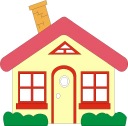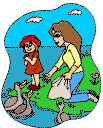Basic Geography: What's a Place?
Part
1: Defining a Place
One
of the most basic things geographers talk about is the idea
of place.
What
is a place? How do you define it?
A
place can be labeled in several different ways.
 First
of all, a place is where people live. Places like this
include houses and apartment buildings, cities and towns,
countries and continents. Each level is a larger collection
of places. Continents have countries. Countries have cities
and towns. Cities and towns have houses and apartment
buildings. When you are talking with someone who doesn't
live where you live, you might say, "I live in a yellow
house" or "I live in Beijing." When you meet someone who
lives far away, she might say, "I live in Egypt" or "I live
in Africa." The yellow house, Beijing, Egypt, and Africa are
all places because they are where people live.
First
of all, a place is where people live. Places like this
include houses and apartment buildings, cities and towns,
countries and continents. Each level is a larger collection
of places. Continents have countries. Countries have cities
and towns. Cities and towns have houses and apartment
buildings. When you are talking with someone who doesn't
live where you live, you might say, "I live in a yellow
house" or "I live in Beijing." When you meet someone who
lives far away, she might say, "I live in Egypt" or "I live
in Africa." The yellow house, Beijing, Egypt, and Africa are
all places because they are where people live.
They
are also places because they are where things are.
Beijing is where the Chinese capital is. Egypt is where the
Pyramids are. Africa is where Egypt is.
 In
the same way, a park is a place where trees and ducks are
and a market is where food is. You could say that a fire
station is a place where the fire engines are. You could
also say that a fire station is a place where firefighters
work.
In
the same way, a park is a place where trees and ducks are
and a market is where food is. You could say that a fire
station is a place where the fire engines are. You could
also say that a fire station is a place where firefighters
work.
 So
far, we have defined a place as where things are or
where people live or work. Going back to our park example,
we could say that a park is a place where people are, too.
These people are not working (unless they are working in the
park). They are enjoying some time away from work. They
might even be feeding ducks. So, a place can be somewhere
that people aren't living or working but just
are.
So
far, we have defined a place as where things are or
where people live or work. Going back to our park example,
we could say that a park is a place where people are, too.
These people are not working (unless they are working in the
park). They are enjoying some time away from work. They
might even be feeding ducks. So, a place can be somewhere
that people aren't living or working but just
are.
Next
page > Place
to Place >
Page 1, 2



 First
of all, a place is where people live. Places like this
include houses and apartment buildings, cities and towns,
countries and continents. Each level is a larger collection
of places. Continents have countries. Countries have cities
and towns. Cities and towns have houses and apartment
buildings. When you are talking with someone who doesn't
live where you live, you might say, "I live in a yellow
house" or "I live in Beijing." When you meet someone who
lives far away, she might say, "I live in Egypt" or "I live
in Africa." The yellow house, Beijing, Egypt, and Africa are
all places because they are where people live.
First
of all, a place is where people live. Places like this
include houses and apartment buildings, cities and towns,
countries and continents. Each level is a larger collection
of places. Continents have countries. Countries have cities
and towns. Cities and towns have houses and apartment
buildings. When you are talking with someone who doesn't
live where you live, you might say, "I live in a yellow
house" or "I live in Beijing." When you meet someone who
lives far away, she might say, "I live in Egypt" or "I live
in Africa." The yellow house, Beijing, Egypt, and Africa are
all places because they are where people live.
 In
the same way, a park is a place where trees and ducks are
and a market is where food is. You could say that a fire
station is a place where the fire engines are. You could
also say that a fire station is a place where firefighters
work.
In
the same way, a park is a place where trees and ducks are
and a market is where food is. You could say that a fire
station is a place where the fire engines are. You could
also say that a fire station is a place where firefighters
work.
 So
far, we have defined a place as where things are or
where people live or work. Going back to our park example,
we could say that a park is a place where people are, too.
These people are not working (unless they are working in the
park). They are enjoying some time away from work. They
might even be feeding ducks. So, a place can be somewhere
that people aren't living or working but just
are.
So
far, we have defined a place as where things are or
where people live or work. Going back to our park example,
we could say that a park is a place where people are, too.
These people are not working (unless they are working in the
park). They are enjoying some time away from work. They
might even be feeding ducks. So, a place can be somewhere
that people aren't living or working but just
are.

